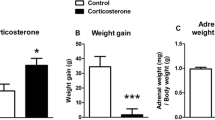Summary
The effects of 6-hydroxydopamine (6-OHDA) lesions on brain adrenergic receptor adaptation to 21 days of treatment with the selective monoamine oxidase type A (MAO-A) inhibitor clorgyline were studied in rats. 6-OHDA pretreatment effectively blocked the decrease in α1-, α2- and β-adrenergic receptor densities observed in response to clorgyline treatment. In saline-treated rats, 6-OHDA reduced norepinephrine (NE) to 8% of control levels, modestly reduced dopamine (DA) to 67% of controls, but did not affect serotonin (5HT) levels in the cortex, Clorgyline administration to shams increased NE and 5HT to 239% and 160% of their respective control levels, but did not effect DA levels. 6-OHDA lesions attenuated clorgyline's effect on cortical NE levels but not 5HT. The results suggest that β-adrenergic receptor adaptation to MAOI's as with tricyclic antidepressants is a response to an increase in catecholamine receptor occupancy, and that a similar molecular mechanism is responsible for the observed clorgyline induced changes in α-adrenergic receptors.
Similar content being viewed by others
References
Aulakh CS, Cohen RM, McLellan C, Murphy DL (1983) Correlations of changes in α-2-adrenoreceptor number and locomotor responses to clonidine following clorgyline discontinuation. Br J Pharmacol 80:10–12
Breese GR, Cooper BR (1977) Chemical lesioning: Catecholamine pathways in methods in psychobiology, Meyers R (ed) Academic Press, New York, pp 27–46
Charney DC, Menkes DB, Heninger GR (1981) Receptor sensitivity and the mechanism of action of antidepressant treatment: Implications for the etiology and therapy of depression. Arch Gen Psychiatry 38:1160–1180
Chiueh CC, Zukowska-Grojec Z, Kirk KL, Kopin IJ (1983) 6-Fluorocatecholamines as false adrenergic neurotransmitters. J Pharmacol Exp Ther 225:529–533
Cohen RM, Aulakh CS, Campbell IC, Murphy DL (1982a) Functional subsensitivity of α2 accompanies reductions in yohimbine binding after clorgyline treatment. Eur J Pharmacol 81:145–148
Cohen RM, Campbell IC, Cohen MR, Torda R, Pickar D, Siever LJ, Murphy DL (1980) Presynaptic noradrenergic regulation during depression and antidepressant drug treatment. Psychiatry Res 3:93–105
Cohen RM, Campbell IC, Dauphin M, Tallman JF, Murphy DL (1982c) Changes in α-and β-receptor densities in rat brain as a result of treatment with monoamine oxidase inhibiting antidepressants. Neuropharmacology 21:293–298
Cohen RM, Ebstein RP, Daly JW, Murphy DL (1982b) Chronic effects of a monoamine-oxidase inhibiting antidepressant: Decrease in functional alpha-adrenergic autoreceptors precede the decrease in norepinephrine stimulated cyclic AMP systems in rat brain. J Neurosci 2:1588–1595
Crews FT, Smith CB (1978) Presynaptic alpha-receptor subsensitivity after long-term antidepressant treatment. Science 202:322–324
Crews FT, Smith CB (1981) Acceleration of beta-receptor desensitization in combined administration of antidepressants and phenoxybenzamine. Nature 290:787–789
Dibner MD, Molinoff PB (1979) Agonist induced change in betaadrenergic receptor density and receptor modified responsiveness in slices of rat cerebral cortex. J Pharmacol Exp Ther 210:433–439
Janowsky A, Steranka LR, Gillespie DD, Sulser F (1982) Role of neuronal signal input in the down-regulation of central noradrenergic receptor function by antidepressant drugs. J Neurochem 39:290–292
Knoll B, Held G, Gyarmati Z (1977) The effect of selective MAO inhibitors on the conditioned avoidance response of Wistar rats. Pol J Pharmacol Pharm 29:291–296
Lowry OH, Rosebrough NJ, Farr AL, Randall RJ (1951) Protein measurement with the Folin phenol reagent. J Biol Chem 193:265–275
Maggi A, U'Prichard DC, Enna SJ (1980) β-Adrenergic regulation of α2-adrenergic receptors in the central nervous system. Science 207:645–646
Munson PJ, Rodbard D (1980) Ligand: A versatile computerized approach for characterization of ligand-binding systems. Anal Biochem 107:220–239
Reisine T (1981) Adaptive changes in catecholamine receptors in the central nervous system. Neuroscience 6:1471–1502
Reisine TD, U'Prichard DC, Wiech NL, Ursillo RC, Yamamura HI (1980) Effects of combined administration of amphetamine and iprindole on brain adrenergic receptors. Brain Res 188:587–592
Schoffelmeer A, Mulder AH (1982) 3H-noradrenaline and 3H-5-hydroxytryptamine release from rat brain slices and its presynaptic alpha adrenergic modulation after long-term desipramine pretreatment. Naunyn-Schmiedeberg's Arch Pharmacol 318: 173–180
Schweitzer JW, Schwartz R, Friedhoff AJ (1979) Intact presynaptic terminals required for beta-adrenergic receptor regulation by desipramine. J Neurochem 33:377–379
Skolnick P, Stolvey LP, Daly JW, Hogler E, Davis JN (1978) Binding of α- and β-adrenergic ligands to cerebral cortical membranes: Effect of 6-hydroxydopamine treatment and relationship to the responsiveness of cyclic AMP-generating systems in two rat strains. Eur J Pharmacol 47:201–210
Sulser F, Vetulani J, Mobley P (1978) Mode of action of antidepressant drugs. Biochem Pharmacol 27:257–261
Svensson T, Usdin T (1978) Feedback inhibition of brain noradrenaline neurons by tricyclic antidepressants: alpha receptor mediation. Science 202:1089–1091
U'Prichard D, Bechtel W, Rouot B, Snyder SH (1979) Multiple apparent alpha noradrenergic receptor binding sites in rat brain: effect of 6-hydroxydopamine. Mol Pharmacol 16:47–60
Valley L, Cardo B, Bockaert J (1981) Modulation of rat brain α-adrenoceptor populations four weeks after stimulation of the nucleus locus coeruleus. Psychopharmacology 74:226–231
Waldmeier PC, Belner AE, Maitre L (1981) Long-term effects of selective MAO inhibitors on MAO activity and amine metabolism. In: Youdim M, Paykel E (eds) Monoamine oxidase inhibitors. The state of the art. Wiley, Chichester, pp 87–102
Winer BT (1971) Statistical principles in experimental design, 2nd edn. McGraw-Hill, New York
Wolfe BB, Harden TK, Sporn JR, Molinoff PB (1978) Presynaptic modulation of beta adrenergic receptors in rat cerebral cortex after treatment with antidepressants. J Pharmacol Exp Ther 207:446–457
Author information
Authors and Affiliations
Rights and permissions
About this article
Cite this article
Cohen, R.M., Aulakh, C., McLellan, C. et al. 6-Hydroxydopamine pretreatment effects on α- and β-adrenergic receptor adaptation to clorgyline. Naunyn-Schmiedeberg's Arch. Pharmacol. 329, 158–161 (1985). https://doi.org/10.1007/BF00501206
Received:
Accepted:
Issue Date:
DOI: https://doi.org/10.1007/BF00501206




